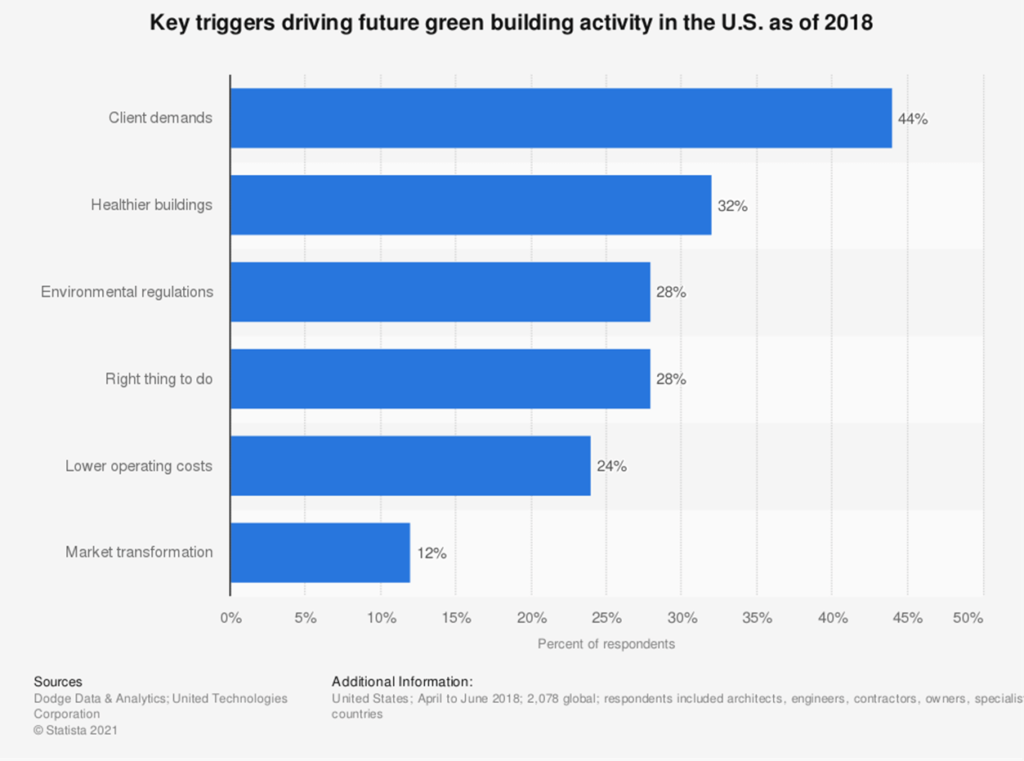Perhaps you are familiar with Green Building Certification Programs such as Leadership in Energy and Environmental Design (LEED), International WELL Building Institute (WELL), or Building Research Establishment Environmental Assessment Method (BREEAM), or maybe you are left scratching your head wondering what this broad string of words or letters has to do with your environmental firm? Regardless of your familiarity, this market is of great interest to many of our clients. Despite the disruptions caused by the pandemic, the Green Building and Products industry has not shown any signs of decline. Those of you who are familiar and regularly perform LEED and WELL projects are reaching out for increased support. However, obtaining credits for certification, though beneficial, can be a nightmare of mazes to complete. It is our goal to make this process as smooth as possible wherever we can.
What is ‘Green Building’? Green can mean many different things to each person. For instance, it can be the types of cleaning products used, reclamation of rainwater, net-zero energy, little to no impact on the environment, occupant factors such as lighting and views of the outdoors, recycling programs, a garden or plants in the office, the list goes on and on. For the purposes of Green Building Certifications, the following definitions apply.
- … the practice of creating structures and using processes that are environmentally responsible and resource-efficient throughout a building’s life cycle from siting to design, construction, operation, maintenance, renovation, and deconstruction. (US EPA, definition used by Wikipedia)
- … the planning, design, construction, and operations of buildings with several central, foremost considerations: energy use, water use, indoor environmental quality, material section and the building’s effects on its site. (US Green Building Council)
- … a building that, in its design, construction or operation, reduces or eliminates negative impacts, and can create positive impacts, on our climate and natural environment. (World Green Building Council)
- … a method of wisely using resources to create high-quality, healthier and more energy-efficient homes and commercial buildings. (Green Building Solutions)
Who’s involved? Building, as you know, involves so many different industries and groups. When adding in the Green Certification, there are several other components to keep in mind. This will likely involve branching out to new contractors and suppliers for building design and execution. Here are a few resources to begin exploring the world of Green Building.
- Green Building Council (World; US, UK, India, etc.)
- International WELL Building Institute
- International Living Future Institute (ILFI)
- US EPA (Energy Star)
- Building Research Establishment (BRE)
- Center for the Built Environment (CBE)
- Forest Stewardship Council (FSC)
- Green Business Certification Inc. (GBCI)
- Global Green
- Sustainable Buildings Industry Council (SBIC)
- Building Green LLC (resources only)
- The Green Building Initiative
- National Association of Home Builders (NAHB)
- National Green Building Standard (ANSI recognized)
- Building Research Establishment Environmental Assessment Method (BREEAM)
Furthermore, Green Building certification is not limited to new office buildings only, though they represent the highest percentage of buildings looking to obtain these credits. There are specialty credits and programs for upgraded or remodeled buildings, schools, hospitals, retail, hotels and hospitality, interior design only, building core/shell only, single family residential, multifamily residential, and more. As summarized below, the reasons for seeking out Green Building Certification also vary greatly.

What is graded or reviewed? There is no universal standard to use but there are several programs that have similar categories and requirements. LEED from USGBC is one of the most widely used for building specifics, especially in the U.S. Another certification program gaining traction is its compliment partner, WELL, for occupant driven considerations. From our experience, The Living Building Challenge seems to be less frequently used in the U.S. though it is gaining momentum. For our international clients, WELL and BREEAM have been the most frequently requested. Major components of these certification programs include:
- Air Quality and Ventilation
- Water Source and Quality
- Natural and Electric Lighting
- Material and Product Sourcing
- Sound Considerations
- Occupant Activity Options
- Community and Neighborhood Developments
- Energy Performance
- Transportation Planning
- Waste Management Programs
- Site Selection and Preparation
Over the next few weeks, we will be releasing several more blogs to help guide you and your team through Green Building Certification programs in relation to water, soil, and air testing. This Green Building series will assist you with navigation and simplification of applicable credits for your LEED, WELL, and BREEAM projects.
For more information on Green Building, please contact us here and be sure to check out more blogs in the series.


